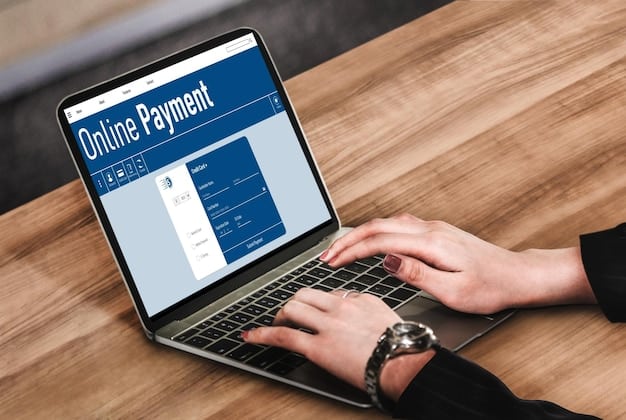Beginner’s Guide: Open & Fund a Brokerage Account in 30 Minutes

Opening and funding a brokerage account doesn’t have to be a daunting task; with this beginner’s guide, learn how to streamline the process and get your account ready for investing in under 30 minutes, setting you on the path to financial growth.
Ready to dive into the world of investing but unsure where to start? This beginner’s guide: how to open a brokerage account and fund it in under 30 minutes will break down the process, so you can start building your financial future today.
Understanding Brokerage Accounts: A Quick Overview
Before diving into the how-to, let’s clarify what a brokerage account actually is. Think of it as your gateway to the stock market and other investment opportunities.
A brokerage account is an investment account that allows you to buy and sell various types of investments, such as stocks, bonds, mutual funds, and exchange-traded funds (ETFs). It’s essential for anyone looking to grow their wealth through investing.
Types of Brokerage Accounts
There are several types of brokerage accounts, each designed to meet different financial goals and needs. Understanding these types is crucial for selecting the right account for you.
- Taxable Brokerage Accounts: These are standard investment accounts where profits are subject to capital gains taxes. They offer flexibility and are suitable for general investment purposes.
- Retirement Accounts (IRAs): These accounts offer tax advantages for retirement savings, such as tax-deferred growth or tax-free withdrawals, depending on the type of IRA (Traditional or Roth).
- Managed Accounts: In these accounts, a professional manages your investments on your behalf, making investment decisions based on your financial goals and risk tolerance.
Choosing the right type of brokerage account depends on your financial goals, investment timeline, and tax situation. Each account type comes with its own set of rules and potential benefits.
Key Features to Look For
When selecting a brokerage account, consider the following key features to ensure it meets your needs:
- Low Fees: Look for accounts with minimal or no commission fees, as these can eat into your investment returns over time.
- Investment Options: Ensure the account offers a wide range of investment options, including stocks, bonds, ETFs, and mutual funds.
- User-Friendly Platform: A platform that is easy to navigate and understand can make investing more accessible and less intimidating.
- Research Tools: Access to research and analysis tools can help you make informed investment decisions.

By understanding these key features, you can choose a brokerage account that suits your investment style and goals, setting you up for success in the stock market.
In summary, a brokerage account is your key to accessing the investment world. By understanding the different types and key features, you can make an informed decision and choose an account that aligns with your financial objectives.
Step-by-Step: Opening Your Brokerage Account
Now that you understand the basics of brokerage accounts, let’s walk through the process of opening one. The following steps will guide you through the application, verification, and setup process.
Opening a brokerage account is generally a straightforward process, but it’s important to follow each step carefully to avoid delays or complications.
Choosing a Brokerage Firm
The first step is selecting a brokerage firm that meets your needs. Consider factors like fees, investment options, platform usability, and customer support.
Some popular brokerage firms include:
- Fidelity: Known for its extensive research tools and broad range of investment options.
- Charles Schwab: Offers a user-friendly platform, low fees, and excellent customer service.
- TD Ameritrade: Provides access to advanced trading tools and educational resources.
Research and compare different brokerage firms to find the one that best fits your investment goals and preferences.
Completing the Application
Once you’ve chosen a brokerage firm, you’ll need to complete an application. This typically involves providing personal information, such as your name, address, date of birth, and Social Security number.
You’ll also need to provide financial information, such as your employment status, income, and net worth. This information helps the brokerage firm assess your risk tolerance and investment experience.
Verification and Approval
After submitting your application, the brokerage firm will verify your information. This may involve checking your identity and credit history.
Once your application is approved, you’ll receive instructions on how to fund your account. This usually involves linking your bank account or transferring funds from another brokerage account.
By following these steps, you can successfully open a brokerage account and start your investment journey. Remember to choose a brokerage firm that aligns with your goals and take the time to complete the application accurately.
Funding Your Account: Quick and Easy Methods
With your brokerage account opened, the next step is to fund it. Here are some quick and easy methods to get your account up and running in no time.
Funding your brokerage account is a critical step in starting to invest. The quicker and easier the process, the sooner you can begin building your portfolio.
Linking Your Bank Account
One of the most common methods for funding a brokerage account is by linking your bank account. This allows you to transfer funds electronically from your checking or savings account to your brokerage account.
Wire Transfers
Wire transfers are another option for funding your account, especially for larger amounts. However, they may involve fees from both your bank and the brokerage firm.
Mobile Deposits
Some brokerage firms offer mobile deposit options, allowing you to deposit checks directly into your account using your smartphone.
- Conveniently deposit checks from anywhere.
- Funds typically available within a few business days.
- Check deposit limits may apply.
Mobile deposits can be a convenient option for those who prefer not to visit a bank branch.
ACH Transfers
Automated Clearing House (ACH) transfers are electronic transfers between banks, commonly used for funding brokerage accounts. They are typically fee-free and easy to set up.

ACH transfers can be set up as recurring transfers, allowing you to automatically fund your account on a regular basis.
By choosing the right funding method, you can quickly and easily fund your brokerage account, setting you up to start investing and achieving your financial goals.
Setting Up Automatic Investments
Setting up automatic investments is a great way to ensure you consistently contribute to your investment portfolio without having to manually transfer funds each time.
Automation can help you stay disciplined with your investing, making it easier to reach your financial goals over time.
Benefits of Automatic Investing
Automatic investing offers several key benefits, including:
- Consistency: Regular contributions, regardless of market conditions.
- Discipline: Eliminates the temptation to skip investments during market downturns.
- Dollar-Cost Averaging: Reduces risk by investing a fixed amount at regular intervals.
These benefits can significantly improve your long-term investment outcomes.
How to Set It Up
Setting up automatic investments typically involves the following steps:
- Log into Your Brokerage Account: Access your account through the brokerage firm’s website or mobile app.
- Navigate to the Transfers Section: Look for options like “Automatic Transfers” or “Recurring Investments.”
- Set the Amount and Frequency: Specify how much you want to invest and how often (e.g., monthly, bi-weekly).
Once you’ve completed these steps, your automatic investments will be set up and running.
Automatic investing can greatly simplify the investment process and help you stay on track with your financial goals. It’s a set-it-and-forget-it approach to building wealth.
Choosing Your First Investments: A Beginner’s Guide
Selecting your first investments can be daunting, but it’s crucial to start somewhere. Here are some beginner-friendly options to consider.
Diversification is key to managing risk, so consider spreading your investments across different asset classes and sectors.
Index Funds
Index funds are a great option for beginners because they offer instant diversification at a low cost. These funds track a specific market index, such as the S&P 500.
ETFs
Exchange-Traded Funds (ETFs) are similar to index funds but trade like stocks on an exchange. They offer flexibility and diversification.
- Low expense ratios compared to actively managed funds.
- Trade like stocks, offering intraday liquidity.
- Diversification across various sectors and asset classes.
Choosing ETFs that align with your investment goals can be a smart move for beginners.
Mutual Funds
Mutual funds pool money from multiple investors to invest in a diversified portfolio of stocks, bonds, or other assets. They are professionally managed and can be a good option for beginners.
When choosing your first investments, consider your risk tolerance, investment goals, and time horizon. Start small and gradually increase your investments as you become more comfortable.
Essential Tips for New Investors
As a new investor, there are several essential tips to keep in mind to ensure your success in the stock market. Here are a few key strategies and considerations.
Investing can be a rewarding journey, but it’s important to approach it with knowledge and caution.
Diversify Your Portfolio
Diversification is one of the most important strategies for managing risk. By spreading your investments across different asset classes, sectors, and geographic regions, you can reduce the impact of any single investment on your overall portfolio.
Stay Informed
Stay informed about market trends, economic news, and company performance. Read financial news, follow reputable analysts, and monitor your investments regularly.
However, avoid making impulsive decisions based on short-term market fluctuations. Stick to your long-term investment strategy.
Start Small
When you’re just starting out, it’s wise to start with small amounts. This allows you to learn the ropes without risking too much capital.
Rebalance Regularly
Rebalancing involves adjusting your portfolio to maintain your desired asset allocation. This ensures that your portfolio remains aligned with your risk tolerance and investment goals.
| Key Point | Brief Description |
|---|---|
| 🚀 Account Setup | Choose a brokerage, complete the application, and get verified. |
| 💰 Funding Methods | Link your bank, wire transfers, mobile deposits, or ACH transfers. |
| 🤖 Automatic Investments | Set recurring investments to maintain discipline and benefit from dollar-cost averaging. |
| 🎯 Investment Choices | Consider index funds, ETFs, or mutual funds for diversified and beginner-friendly options. |
Frequently Asked Questions
▼
Some brokerage accounts don’t have a minimum deposit requirement, while others may require a minimum of $500 or $1,000. It depends on the brokerage firm and the type of account you choose.
▼
Yes, most brokerage accounts are insured by the Securities Investor Protection Corporation (SIPC), which protects up to $500,000 in securities, including $250,000 for cash claims.
▼
Investments in a taxable brokerage account are subject to capital gains taxes when you sell them for a profit. The tax rate depends on how long you held the investment.
▼
Yes, you can generally withdraw money from your brokerage account at any time, but keep in mind that selling investments may trigger capital gains taxes.
▼
Consider your risk tolerance, investment goals, and time horizon. Start with diversified options like index funds or ETFs, and gradually explore other investments as you gain experience.
Conclusion
Opening and funding a brokerage account is a straightforward process that can be completed in under 30 minutes. By following this beginner’s guide, you can confidently start your investment journey and build a solid foundation for your financial future.



